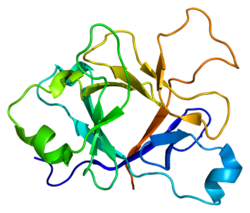Interleukin 36 receptor antagonist (IL-36RA) is a member of the interleukin-36 family of cytokines. It was previously named Interleukin-1 family member 5 (IL1F5). [5] [6] [7] [8]
Contents
The protein is known to inhibit the effects of Interleukin-36 cytokines (IL-36α, IL-36β and IL-36γ) via competing with their receptor IL-36R/IL1RL2 and thereby inhibiting their proinflammatory effects. [9]






